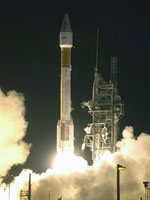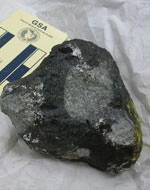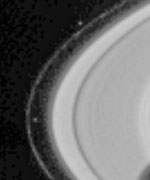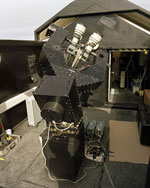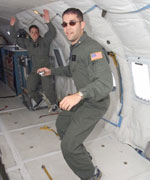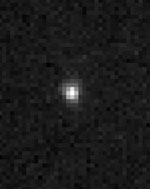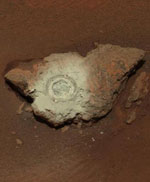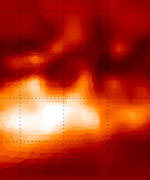
Image credit: ESO
Titan, the largest Saturnian moon and the second largest moon of the solar system (only Jupiter’s Ganymede is slightly larger), is the only satellite known with a substantial atmosphere. It is composed mainly of nitrogen (like that of the Earth) and also contains significant amounts of methane. Opaque orange hazes and clouds of complex organic molecules effectively shield the solid surface from view, cf. e.g. the Voyager images.
Recent spectroscopic and radar observations suggest that there are huge surface reservoirs of liquid hydrocarbonates and a methane-based meteorological cycle similar to Earth’s hydrological cycle. This makes Titan the only known object with rainfall and potential surface oceans other than the Earth and thus a tantalizing research object for the study of pre-biotic chemistry and the origin of life on Earth.
The Huygens probe launched from the NASA/ESA Cassini-Huygens mission will enter Titan’s atmosphere in early 2005 to make measurements of the physical and chemical conditions, hopefully surviving the descent to document the surface as well.
Coordinated ground-based observations will provide essential support for the scientific return of the Cassini-Huygens encounter. However, only 8-10 m class telescopes with adaptive optics imaging systems or space-borne instruments can achieve sufficient image sharpness to attain a useful level of detail.
The new map of a large part of Titan’s surface, shown in PR Photo 11a/04, represents an important contribution in this direction.
A question of atmospheric windows
The first intriguing views of Titan’s surface were obtained by the Hubble Space Telescope (HST) in the 1990’s. From the ground, images were obtained in 2001-2 with the Keck II and Gemini North telescopes and more recently with the ESO Very Large Telescope (VLT), cf. ESO PR Photos 08a-c/04. All of these observations were made through a single narrow-band filter at a time.
The wavelengths used for such observations are critical for the amount of surface detail captured on the images. Optimally, one would look for a spectral band in which the atmosphere is completely transparent; a number of such “windows” are known to exist. But although the above observations were made in wavebands roughly matching atmospheric windows and do show surface features, they also include the light from different atmospheric layers. In a sense, they therefore correspond to viewing Titan’s surface through a somewhat opaque screen or, more poetically, the sight by an ancient sailor, catching for the first time a glimpse of an unknown continent through the coastal haze.
One narrow “window” is available in the near-infrared spectral region near wavelength 1.575 ?m. In February 2004, an international research team [1] working at the ESO VLT at the Paranal Observatory (Chile) obtained images of Titan’s surface through this spectral window with unprecedented spatial resolution and with the lowest contamination of atmospheric condensates to date.
They accomplished this during six nights (February 2, 3, 5, 6, 7 and 8, 2004) at the time of the commissioning phase of a novel high-contrast imaging mode for the NACO adaptive optics instrument on the 8.2-m VLT YEPUN telescope, using the Simultaneous Differential Imager (SDI) [2]. This novel optical device provides four simultaneous high-resolution images (PR Photo 11b/04) at three wavelengths around a near-infrared atmospheric methane absorption feature.
The main application of the SDI is high-contrast imaging for the search for substellar companions with methane in their atmosphere, e.g. brown dwarfs and giant exoplanets, near other stars. However, as the present photos demonstrate, it is also superbly suited for Titan imaging.
Simultaneous Views of Titan’s Surface and Atmosphere
Titan is tidally-locked to Saturn, and hence always presents the same face towards the planet. To image all sides of Titan (from the Earth) therefore requires observations during almost one entire orbital period, 16 days. Still, the present week-long observing campaign enabled the team to map approximately three-quarters of the surface of Titan.
A new map of the surface of Titan (in cylindrical projection and covering most, but not all of the area imaged during these observations) was created. For this, the simultaneous “atmospheric” images (at waveband 1.625 ?m) were “subtracted” from the “surface” images (1.575 and 1.600 ?m) in order to remove any residual atmospheric features present in the latter. The ability to subtract simultaneous images is unique to the SDI camera [2].
This truly unique map shows the fraction of sunlight reflected from the surface – bright areas reflect more light than the darker ones. The amount of reflection (in astronomical terms: the “albedo”) depends on the composition and structure of the surface layer and it is not possible with this single-wavelength (“monochromatic”) map alone to elucidate the true nature of those features.
Nevertheless, recent radar observations with the Arecibo antenna have provided evidence for liquid surfaces on Titan, and the low-reflection areas could indicate the locations of those suspected reservoirs of liquid hydrocarbonates. They also provide a possible source for the replenishment of methane that is continuously lost in the atmosphere because of decomposition by the sunlight.
Presumably, the bright, highly reflective regions are ice-covered highlands.
Provisional names of the new features
A comparison with an earlier NACO image obtained through another filter is useful. It demonstrates the importance of employing a filter that precisely fits the atmospheric window and hence the gain of clarity with the present observations. It also provides independent confirmation of the reality of the gross features, since the observations are separated by 15 months in time.
Over the range of longitudes which have been mapped during the present observations (PR Photo 11a/04), it is obvious that the southern hemisphere of Titan is dominated by a single bright region centered at approximately 15? longitude. (Note that this is not the so-called “bright feature” seen in the HST images at longitude 80? – 130?, an area that was not covered during the present observations).
The equatorial area displays the above mentioned, well-defined dark (low-reflection) structures. In order to facilitate their identification, the team decided to give these dark features provisional names – official names will be assigned at a later moment by the Working Group on Planetary System Nomenclature of the International Astronomical Union (IAU WGPSN). From left to right, the SDI team [1] has referred to these features informally as: the “lying H”, the “dog” chasing a “ball”, and the “dragon’s head”.
Original Source: ESO News Release
